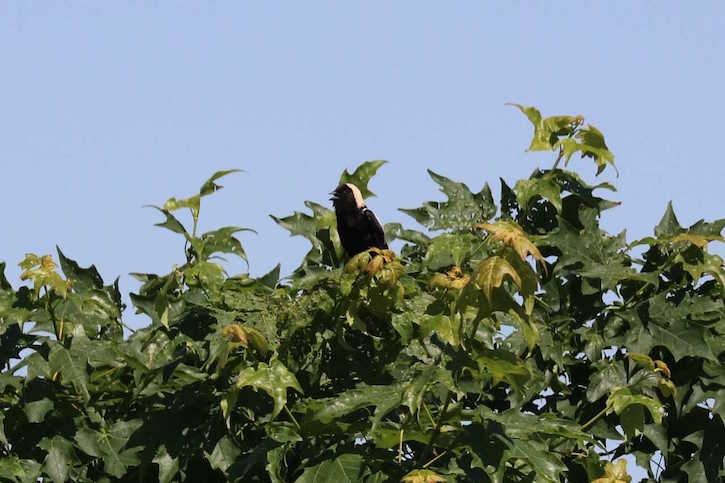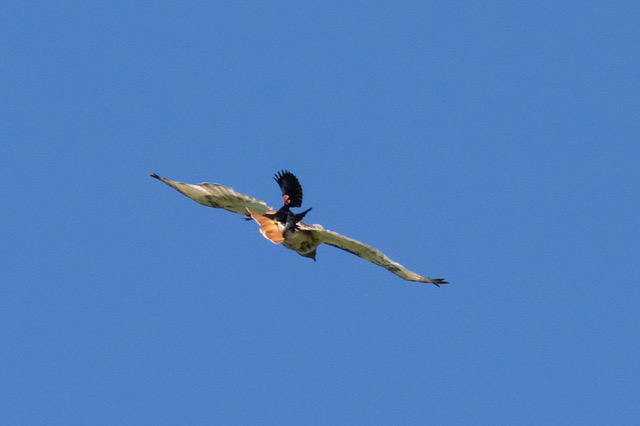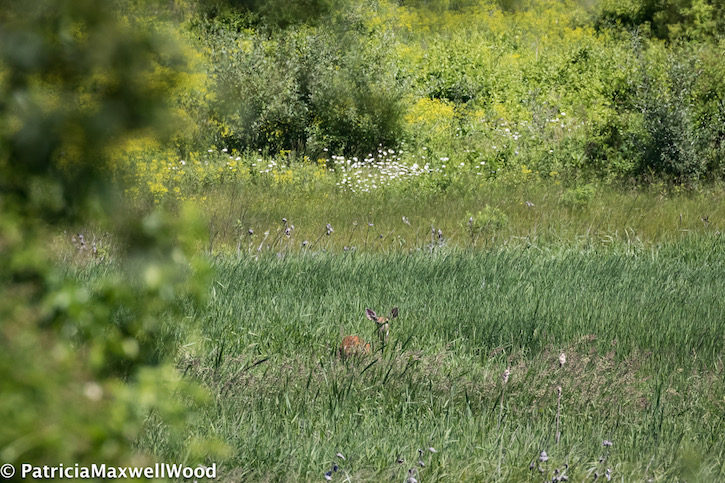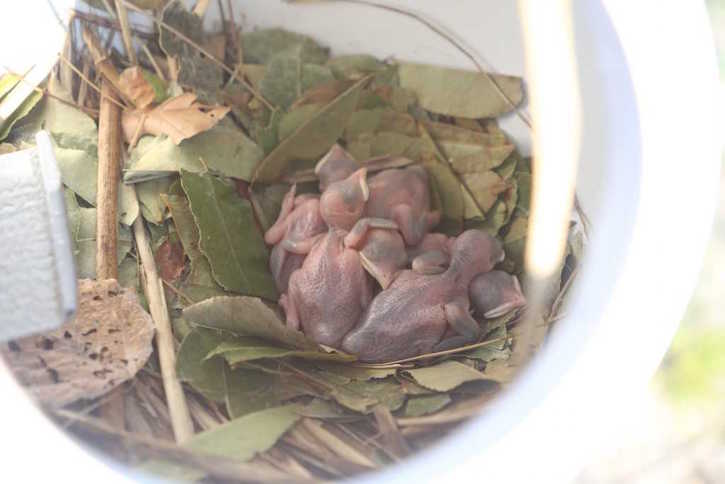On June 12, Lynette Leka co-led Wednesday Morning Birding with me, and we carried on our annual spring tradition of visiting Woodsom Farm in Amesbury. Going there is a leisurely experience, as we walk out into thefarm’s great fields to observe grassland birds. Thanks to the City of Amesbury, the farm’s 130 acres of fields are managed to optimize nesting conditions for Bobolinks and Eastern Meadowlarks. The number of Bobolinks at Woodsom Farm is truly amazing, not only because of the size of the habitat, but because years of successful breeding have resulted in avery high density of birds. We strolled along the rolling hillocks, pausing to watch the activity and listen to the ebullient songs of lots and lots of Bobolinks. The males were, of course, most obvious as they sang from perches and displayed their magnificently slow courtship flights. Occasionally a female would make a display flight, but of another sort: a beeline for about 20 to 50 yards, enticing males to chase her. We did see one good chase when two males took off after a prospective mate. Let the fastest male win! It does seem strange that they have to go through all that, even after working hard at their own display flights.

We expected to see and hear Eastern Meadowlark(s) from the heavy fence posts and trees that surround a small portion of field near the farmhouse. Instead, we heard our first meadowlark song from the middle of a large, gently sloping hillside. That bird dashed off and only gave away his identity with the telltale white outer tail feathers, then disappeared in the tall grass. We continued up to the highest point of the “dog-walking road,” where there are always lots of Savannah Sparrows singing. This time was no exception.


As we passed by a line of trees that follows the road, we listened and looked for other species, picking up some of the usual suspects. While a snatch of cuckoo song was heard by some, it didn’t continue, and the robust activity of a Northern Mockingbird in our vicinity made us wonder who had really made the sound. In such an open place there should be buteos, so it was no surprise to watch two Red-winged Blackbirds attacking a Red-tailed Hawk. They followed that hawk well above where a Red-winged Blackbird would ever normally go. Finally, as we made the return to the vehicles and passed by the railroad tie-bound pasture, our luck with meadowlarks at last came through. One perched for a good long while on the fence, and while we were taking turns viewing it through the scope, a few others flew above the fields.




Having bathed sufficiently in the Bobolink song “bubble bath,” we decided to stop at Pike’s Bridge Road on the way back to Joppa. Now that the trees have fully leafed out, it is easy to see what has happened to the forest at that beloved property. Last year there was a very heavy toll on the oak canopy from a severe outbreak of gypsy moths. A great number of the old twisty oaks that comprised the canopy have either died altogether or lost the branches at their tops. We observed a very lush understory of shrubs and young trees, and we heard a number of common species. It would be interesting to do a rigorous census there and see how the mix of birds might have changed relative to years of eBird data. Are canopy species like Red-eyed Vireos and Scarlet Tanagers less common now?

We headed back to Joppa, pondering the sometimes shocking vagaries of annual cycles of both native and nonnative organisms in our North Shore ecosystems, but happy that people were able to manage one environment and achieve a positive outcome. We are very grateful to the members of Amesbury’s Conservation Commission, Open Space Committee, Mayor’s Office, and DPW for fostering such a great grassland bird community at Woodsom Farm. What can you do in your town? Below is a photo of one other thing that some folks do to help bird populations: they put up and monitor homes for birds – in this case, Purple Martins. Lynette reports that the leaves that are in the nest, and the one held by a martin in Patti Wood’s photo last week, are from a Serviceberry, which we humans think may protect the birds from ectoparasites such as bird lice.

Our list:
Ducks (0)
Double-crested Cormorant (1) – seen in the Merrimack as we drove across.
Great Blue Heron (1) – high above the fields.
Great Egret (3) – various along the route.
Turkey Vulture (2) – Joppa Flats EC.
Osprey (1) – JFEC.
Red-tailed Hawk (3) Woodsom Farm.
Shorebirds (0)Mourning Dove (5) – various.
Chimney Swift (6) – Woodsom.
“Traill’s” Flycatcher (1) – too quiet to ID at Woodsom.
Eastern Phoebe (1) – Woodsom.
Blue Jay (1) – Woodsom.
American Crow (1) – Woodsom.
Barn Swallow (8) – Woodsom.
Black-capped Chickadee (3) – Pike’s Bridge Road (PBR).
Tufted Titmouse (5) – various.
Eastern Bluebird (1) – Woodsom.
American Robin – common.
Gray Catbird (6) – various.
Northern Mockingbird (2) – Woodsom.
European Starling – common.
Ovenbird (3) – PBR.
Common Yellowthroat (7) – various.
Yellow Warbler (6) – various.
Chipping Sparrow (4) – various.
Savannah Sparrow (8) – Woodsom.
Song Sparrow – common.
Northern Cardinal (1) – Woodsom.
Rose-breasted Grosbeak (1) – PBR.
Bobolink (35?) – Woodsom.
Red-winged Blackbird – common.
Eastern Meadowlark (5) – Woodsom.
Common Grackle (5) – various.
Brown-headed Cowbird (4) – Woodsom.
Baltimore Oriole (2) – Woodsom.
House Finch (4) – Woodsom.
American Goldfinch (2) – Woodsom.
House Sparrow (5) – Woodsom.

